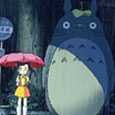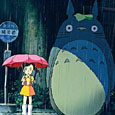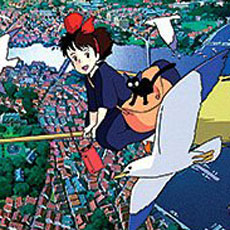Studio Ghibli (1988), Walt Disney Home Entertainment (May 21, 2013), 1 BD + 1 DVD, 86 mins plus supplements, 1.85:1 ratio, 2.0 DTS-HD Master Audio, Rated G, Retail: $39.99
Storyboard:
A young family experiences help from playful spirits of nature during a difficult time in their lives, in what is perhaps Studio Ghibli’s most beloved film.
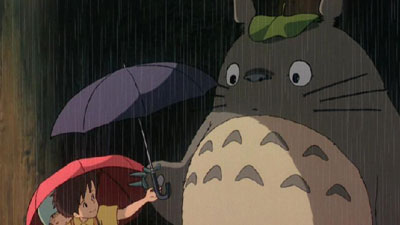
The Sweatbox Review:
(Note: Portions of this review appeared in our reviews of previous DVD editions of this film, now with updates about the new Blu-ray Combo Pack.)
Following his rather adventurous features Nausicaa and Castle In The Sky, Hayao Miyazaki set out to create a film set in Japan which could be enjoyed by all ages. He wrote My Neighbor Totoro himself, intending it to be a gently told yet harshly true-to-life tale that juxtaposed our everyday reality with magical creatures. The mix of themes provides the film its uniqueness, and has had some critics hailing it a classic.
Oddly enough, it was originally double-billed in Japan with the Ghibli film Grave Of The Fireflies, a devastating World War II film. This may seem like an odd couple, and indeed it was; but there was a reason for it. Simply put, My Neighbor Totoro was seen as a financial risk. The idea was to get the publisher of the well known Grave Of The Fireflies story to produce a film version which Ghibli would animate; and then pair the two films together to enhance the potential viewership. Predictably, the double bill was not entirely successful, as the two films had wildly different tones and targeted different types of audiences. Still, each film is now seen as a classic, and Totoro has in particular endured as a merchandizing success in Japan. The character of Totoro is also now seen as a mascot of the studio.
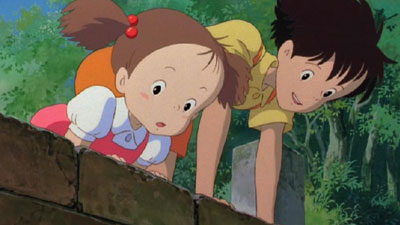
Two sisters, eleven year-old Satsuki and four-year old Mei (played by real-life sisters Dakota and Elle Fanning), move to the country with their father, while their mother (Filipino performer Lea Salonga) recuperates from an illness in a nearby hospital. They are quick to explore their new surroundings, including their new character home and the surrounding yard, while admiring the rice fields just across the road. Early in their explorations, they encounter little fuzzy black creatures in the house, which they learn are “soot sprites,” and thus they are introduced to the magic present around them. The soot sprites are the least of the wonders they encounter, however.
Their father (Tim Daly) works at a Tokyo university, and as he commutes there daily by bus and rail, this leaves the girls plenty of time for looking around their new place. One day, Mei spots a pale, translucent creature; and then a larger blue one joins that one. Mei gives chase to them, and her chase eventually leads into a tunnel formed within the foliage. She finally emerges into a large cavern where sleeps an immense creature similar to the smaller ones she followed, and which we come to know as a Totoro. Mei befriends the creature, and later falls asleep, only to be discovered later by her sister and father. Mei relates her story of the Totoro, and surprisingly her father believes her, explaining that she has met a spirit of the forest.
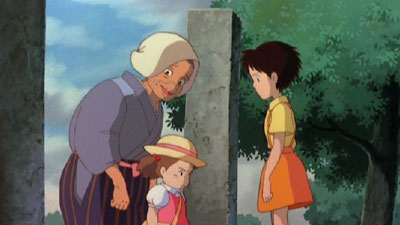
Vignettes of Tatsuki and Mei at the school, and talking with their neighbor “Granny” follow, leading to a more magical sequence where the two sisters try to bring their father an umbrella. While waiting at a bus stop, they end up meeting the huge Totoro once again, and encounter a “cat bus.” Their relationship with the forest spirits pays dividends when they wish to have some acorns sprout, and more importantly later on when Mei goes missing while trying to walk all the way to the hospital to find her mother. Mei’s disappearance follows the receipt of a disturbing telegram, which gives the story some sudden emotional weight. The drama of the search, and the question of the mother’s health, provides all the conflict the story needs. There are no villains here, no bullies to be defeated. There are only the everyday fears of loss and mortality to be conquered. In the end, the girls maybe didn’t really need the help of the forest spirits, but they did have their burdens eased. With the recent experiences behind them, they are more ready to face future challenges on their own.
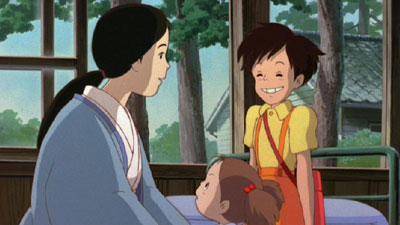
Miyazaki excels at keeping his stories planted in a true sense of reality while adding in fantasy elements. The incredible occurrences in My Neighbor Totoro are presented matter-of-factly, as characters who feel very “real” are allowed to experience fantastic occurrences with little fanfare, grounding the film while at the same time making the audience accept what they once thought to be impossible. It’s a neat trick.
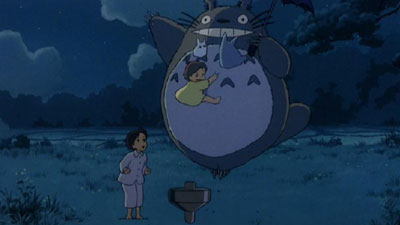
This simple movie generally keeps a quiet tone, and its plotting may be described as leisurely, but I found that the time spent with this film passed surprisingly quickly. What allows this to happen, of course, is the appeal of the characters. When you spend time with people you like, time never seems to drag. In the end, this feels like a minor film by a great filmmaker; but as its fans will attest, it has an unassuming magic that gives it appeal that goes beyond trying to impress anyone with quick edits or stunning visual effects. In truth, the animation is not all that impressive, and the muted colors do not seem to be trying too hard to overwhelm anyone with their splendor. The real special effect here is storytelling, performed by a master.
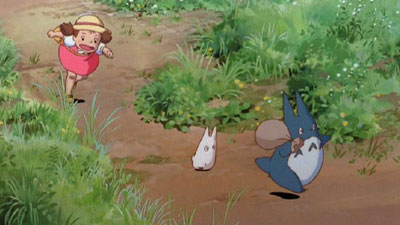
Is This Thing Loaded?
The Blu-ray carries over virtually everything from the very good 2010 DVD release. One can view the Complete Storyboards for the film, while listening to it in either Japanese or English, with subtitles available in English or French, as well as English captions.
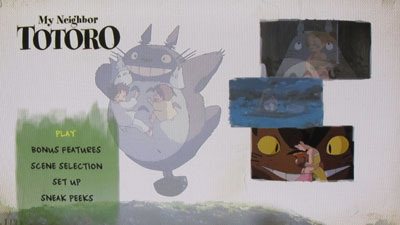
The 2010 DVD has a broad collection of extras it termed “The World Of Ghibli”, and was subdivided into various sections. Here, they are all presented more simply under the bonus features menu, and now mostly are in high definition. The first few featurettes have materials that are in Japanese, with English or French subtitles, beginning with three short featurettes using interviews with director Hayao Miyazaki and producer Toshio Suzuki. In Creating My Neighbor Totoro (2:58), Miyazaki discusses how My Neighbor Totoro began as an idea for a storybook, and fifteen years later became an animated film. Creating The Characters (4:25) has Suzuki and mainly Miyazaki explaining how the characters were conceived and presented, and what Miyazaki’s influences were. In The Totoro Experience (2:00), the two men describe how the film’s initial unsuccessful theatrical run was not unexpected, but how its later popularity came as a surprise.
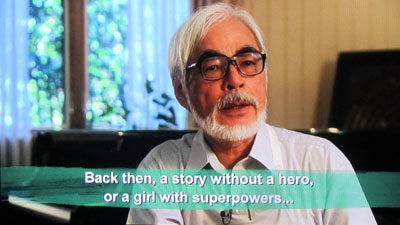
Producer’s Perspective: Creating Ghibli (1:24) may be brief, but it does contain some essential information, as Suzuki explains the origin of the Ghibli name, and how it is pronounced. The Locations Of Totoro (28:34) is a generous excerpt from the Japanese documentary The Scenery Of Ghibli. This excellent travelogue visits Sayama Hills and the Tokyo suburbs, exploring the land, creatures, and people of the area, and nicely compares everything to what is so accurately captured in the film. Scoring Miyazaki (7:19) is a nice interview with Miyazaki’s composer Joe Hisaishi.

The Original Japanese Trailer (1:49) is here as well, plus Behind The Microphone (5:39), which has some enjoyable comments by the Fanning sisters, Lea Salonga, Tim Daly, and Pat Carroll.
The 2010 DVD’s sections highlighting other Ghibli films, and the interactive “World Of Ghibli” map, are not here. A small loss, and not a crucial one, but completists may wish to hold on to their old DVDs if they feel like they will miss having these features.
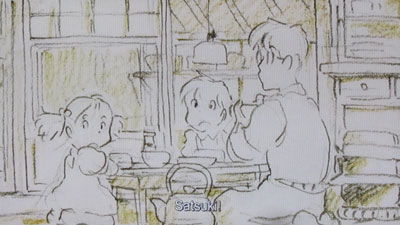
The Blu-ray’s Previews promote the upcoming Blu-ray release of The Little Mermaid, the theatrical release of Monsters University, and the direct-to-video Iron Man/Hulk: Heroes United. Further Sneak Peeks from the menu offer ads for Disney Movie Rewards, the Disney Infinity game, Radio Disney, and the Many Adventures Of Winnie The Pooh Blu-ray.
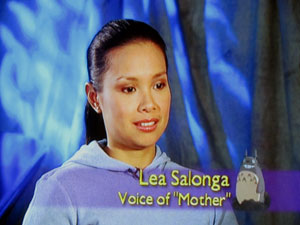
The DVD in this set, being the same disc as the 2010 edition, only has Previews which were more appropriate at the time of that DVD’s initial release, including those for Beauty And The Beast: Diamond Edition, Toy Story 3, and the 2010 wave of Studio Ghibli DVDs. Further Sneak Peeks available from the DVD menu include those for the Toy Story Blu-rays, The Princess And The Frog, Tinker Bell And The Great Fairy Rescue, Ponyo, Disney’s Friends For Change: Project Green, an anti-bootlegging spot called Genuine Treasure, Disney Movie Rewards, and Disney Blu-ray. Unlike the other Ghibli DVDs in that wave, there was no introduction by John Lasseter (and there was none on the earlier 2006 release, either). The 2006 DVD had the opening and closing animation without credits, but that is still dropped from this release. Again, not a big loss, but notable all the same.
Case Study:
This set includes a new Blu-ray, plus the first disc of the previous two-disc DVD (the disc art and contents are exactly the same as before). Each disc fits into a holder on either side of the standard Blu-ray case, and there is a Disney Movie Rewards insert inside as well. The slipcover is tastefully embossed only in the lettering, and the spine carries on the golden motif established by the DVDs of three years back.
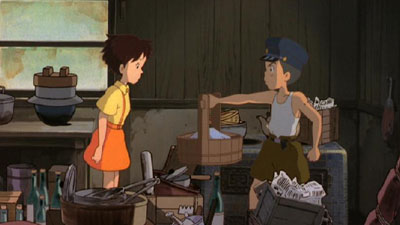
Ink And Paint:
In the review for the 2010, I wrote that “those accustomed to watching American animation may be under-whelmed by the visual experience of My Neighbor Totoro. Colors are kept relatively muted, and the animation itself is more inventive than smooth. Of course, the Ghibli artists later would prove themselves to be quite adept at lighting up a screen with colors when they wanted to (see Spirited Away), but here the emphasis is on maintaining a realistic setting, in order to have the viewer more willing to accept the unbelievable, as well as to relate better to the two girls. The emotional nature of the film might have been undercut by brighter colors, and so the choice of the director must be respected.”
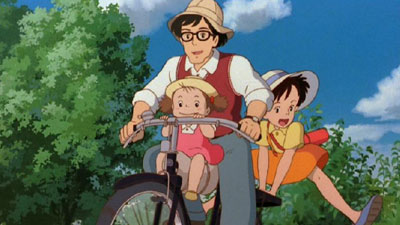
Watching this Blu-ray is a similar experience, but the additional sharpness of the image makes me appreciate the film all the more. Though the colors remain relatively muted, the crispness of the lines and slight additional vibrancy of the colors makes all the difference for me. No longer under-whelmed, I found myself liking the color choices even better. The transfer is also remarkably free of any defects, either physical or digital. It’s a very clear and solid presentation.
Note that these screen captures are mostly taken from the DVD.
Scratch Tracks:
The audio is the barest of upgrades over the DVD. English, Japanese and French audio tracks are all offered in lossless 2.0 DTS-HD Master Audio, which is welcomed, but the change from the DVD’s lossy tracks is largely imperceptible in this case. This is a quiet film in terms of lacking bombastic effects, but the sound design is deceptively rich, with ambient sounds of outdoor life helping to create an auditory illusion of living in the country. Subtitles are available in English and French, and there is also separate English captioning for the hearing impaired.
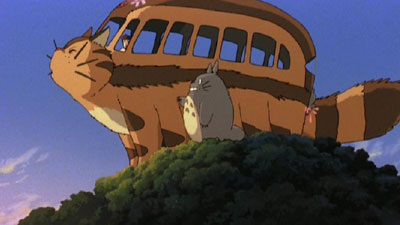
Final Cut:
A film like this doesn’t exactly demand a hi-def upgrade, but for the studio’s biggest fans this will undoubtedly be a “must” purchase. If you can manage to sell your old DVD before buying this Combo Pack, you will only lose some minor features, while ensuring that you have the best disc available. And if you haven’t purchased Totoro before, then doing so now is certainly recommended. It’s a small film in some respects, with simple animation, but still a masterful example of storytelling— and perfect for families.
 | ||
 |


